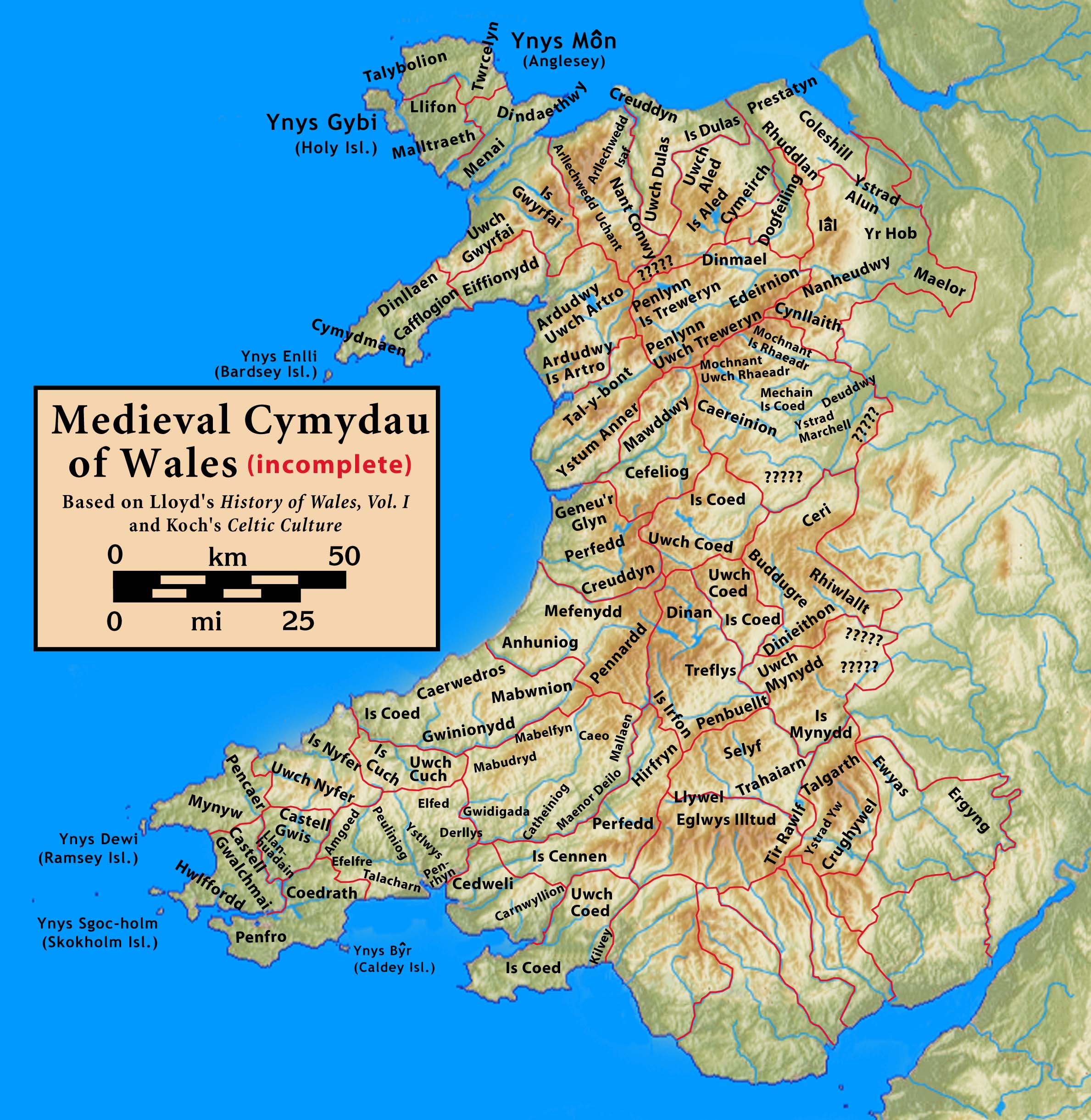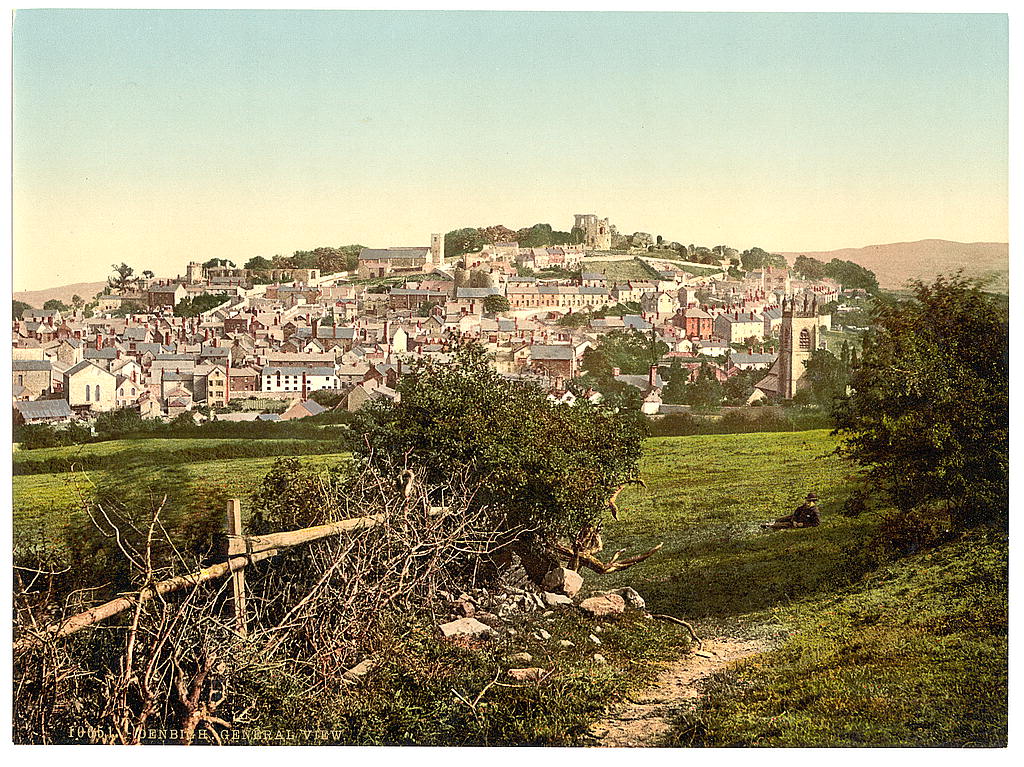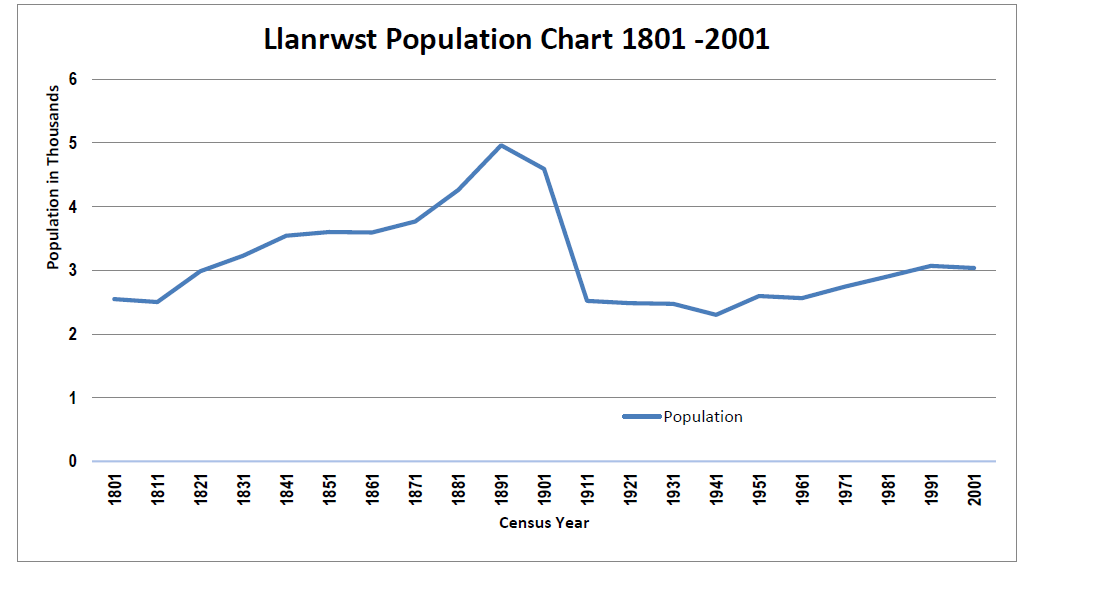|
Ystrad Marchell
Ystrad Marchell sometimes Strad Marchell ( en, Vale of Marchell) was a medieval commote (''cwmwd'') in the cantref of Ystlyg in the Kingdom of Powys. It roughly coincides with the parish of Welshpool. It lay at the east of the kingdom, bordering the cantref of Caereinion to the west and south, and the cantref of Mechain to the north-west. Within Ystlyg the other commotes were Deuddwr to the north, Llannerch Hudol to the south and Y Gorddwr (or Corddwr) to the east. The cantref of Ystlyg (excluding Y Gorddwr) corresponds to the later hundred of Deuddwr. Ystrad Marchell was founded by or named for Marchell, a sister of the fifth or sixth century saint Tyfrydog. She was also a saint and is associated with Capel Marchell near Llanrwst, and Ffynnon Farchell ( en, Well of St Marcella) and St Marcella's Parish Church (formerly Llanfarchell) in Eglwys Wen near Denbigh. The valley of Ystrad Marchell is the site of the medieval Cistercian monastery of Strata Marcella (Latinised form of ... [...More Info...] [...Related Items...] OR: [Wikipedia] [Google] [Baidu] |
Wales
Wales ( cy, Cymru ) is a Countries of the United Kingdom, country that is part of the United Kingdom. It is bordered by England to the Wales–England border, east, the Irish Sea to the north and west, the Celtic Sea to the south west and the Bristol Channel to the south. It had a population in 2021 of 3,107,500 and has a total area of . Wales has over of coastline and is largely mountainous with its higher peaks in the north and central areas, including Snowdon (), its highest summit. The country lies within the Temperateness, north temperate zone and has a changeable, maritime climate. The capital and largest city is Cardiff. Welsh national identity emerged among the Celtic Britons after the Roman withdrawal from Britain in the 5th century, and Wales was formed as a Kingdom of Wales, kingdom under Gruffydd ap Llywelyn in 1055. Wales is regarded as one of the Celtic nations. The Conquest of Wales by Edward I, conquest of Wales by Edward I of England was completed by 1283, th ... [...More Info...] [...Related Items...] OR: [Wikipedia] [Google] [Baidu] |
Tyfrydog
Tyfrydog (sometimes given as Tyvrydog) was a Christian from north-west Wales in the fifth or sixth century, who was later venerated as a saint. He is said to have established a church in Anglesey, and although no part of the original structure remains, the current church is still dedicated to him. A nearby standing stone is said to be the remains of a man who he punished for stealing a bible from the church. Life and family Little is known for certain about Tyfrydog's life, and his dates of birth and death are unknown. He is said to have lived towards the end of the sixth century, although another account has him as active during the middle of the fifth century.Williams, pp. 503–504. His father is recorded as being Arwystli Glof ab Seithenyn, active in the middle of the sixth century. Both he and his father are said to have been part of the Christian community on Bardsey Island, at the tip of the Llŷn Peninsula in north-west Wales. Some of his siblings are also vener ... [...More Info...] [...Related Items...] OR: [Wikipedia] [Google] [Baidu] |
Ynysymaengwyn
Ynysymaengwyn was a gentry house in the parish of Tywyn, Gwynedd (formerly Merioneth), situated near the left bank of the River Dysynni. The name means 'the white stone island'. Early history It was in the commote of Ystumanner or Ystum Anner that Gruffydd ap Gwenwynwyn did homage and swore fealty to Llywelyn ap Gruffudd on 12 December 1263. In return he was made a vassal lord and the lands taken from him about six years earlier were restored to him. The commote was in the cantref of Meirionnydd. From the late medieval period until the twentieth century, Ynysymaengwyn, situated roughly a mile from Tywyn by the road to Bryn-crug, was by far the most powerful estate in the parish. The family's wealth is revealed in official records and also in the Welsh poetry composed to its leading members. The estate may be traced back to the days of Gruffudd ab Adda of Dôl-goch and Ynysymaengwyn, bailiff of the commote of Ystumanner in 1330 and 1334, whose effigy is thought to lie in St C ... [...More Info...] [...Related Items...] OR: [Wikipedia] [Google] [Baidu] |
Llywelyn Ap Gruffudd
Llywelyn ap Gruffudd (c. 1223 – 11 December 1282), sometimes written as Llywelyn ap Gruffydd, also known as Llywelyn the Last ( cy, Llywelyn Ein Llyw Olaf, lit=Llywelyn, Our Last Leader), was the native Prince of Wales ( la, Princeps Walliae, links=no; cy, Tywysog Cymru, links=no) from 1258 until his death at Cilmeri in 1282. Llywelyn was the son of Gruffydd ap Llywelyn Fawr and grandson of Llywelyn the Great, and he was one of the last native and independent princes of Wales before its conquest by Edward I of England and English rule in Wales that followed, until Owain Glyndŵr held the title during the Welsh Revolt of 1400–1415. Genealogy and early life Llywelyn was the second of the four sons of Gruffydd, the eldest son of Llywelyn the Great, and Senana ferch Caradog, the daughter of Caradoc ap Thomas ap Rhodri, Lord of Anglesey. The eldest was Owain Goch ap Gruffydd and Llywelyn had two younger brothers, Dafydd ap Gruffydd and Rhodri ap Gruffydd. Llywelyn is ... [...More Info...] [...Related Items...] OR: [Wikipedia] [Google] [Baidu] |
Fealty
An oath of fealty, from the Latin ''fidelitas'' (faithfulness), is a pledge of allegiance of one person to another. Definition In medieval Europe, the swearing of fealty took the form of an oath made by a vassal, or subordinate, to his lord. "Fealty" also referred to the duties incumbent upon a vassal that were owed to the lord, which consisted of service and aid.Coredon ''A Dictionary of Medieval Terms and Phrases'' p. 120 One part of the oath of fealty included swearing to always remain faithful to the lord. The oath of fealty usually took place after the act of homage, when, by the symbolic act of kneeling before the lord and placing his hands between the hands of the lord, the vassal became the "man" of the lord. Usually, the lord also promised to provide for the vassal in some form, either through the granting of a fief or by some other manner of support.Saul "Feudalism" ''Companion to Medieval England'' pp. 102-105 Typically, the oath took place upon a religious object such ... [...More Info...] [...Related Items...] OR: [Wikipedia] [Google] [Baidu] |
Gruffydd Ap Gwenwynwyn
Gruffydd ap Gwenwynwyn (died c. 1286) was a Welsh king who was lord of the part of Powys known as Powys Wenwynwyn and sided with Edward I in his conquest of Wales of 1277 to 1283. Gruffydd was the son of Gwenwynwyn and Margaret Corbet. He was still a child when his father, who had been driven out of his princedom by Llywelyn the Great, died in exile in 1216. He spent his youth in England, maintained by the king, and did not return to Wales until after Llywelyn's death. When Dafydd ap Llywelyn was forced to come to terms with King Henry III of England in 1241, Gruffydd was given most of the lands formerly held by his father, paying homage to Henry for them. Around this time he married Hawise, daughter of John Lestrange of Knockin. When Llywelyn ap Gruffudd increased his power in Wales after 1255, Gruffydd continued to support the crown, and in 1257 he was again driven into exile. In 1263 he agreed to transfer his allegiance to Llywelyn under threat of being stripped of his lands, ... [...More Info...] [...Related Items...] OR: [Wikipedia] [Google] [Baidu] |
Madog Ap Maredudd
Madog ap Maredudd ( wlm, Madawg mab Maredud, ; died 1160) was the last prince of the entire Kingdom of Powys, Wales and for a time held the Fitzalan Lordship of Oswestry. Madog was the son of King Maredudd ap Bleddyn and grandson of King Bleddyn ap Cynfyn. He followed his father on the throne of Powys in 1132. He is recorded as taking part in the Battle of Lincoln in 1141 in support of the Earl of Chester, along with Owain Gwynedd's brother Cadwaladr ap Gruffydd and a large army of Welshmen. In 1149 he is recorded giving the commote of Cyfeiliog to his nephews Owain Cyfeiliog and Meurig. The same year Madog was able to rebuild Oswestry Castle, a fortress of William Fitzalan. It would seem likely that he had gained both the fortresses of Oswestry and Whittington in 1146. Defeat by Gwynedd At this time the King of Gwynedd, between 1149 and 1150, Owain Gwynedd was exerting pressure on the borders of Powys, despite the fact that Madog was married to Susanna, Owain's sister. Arou ... [...More Info...] [...Related Items...] OR: [Wikipedia] [Google] [Baidu] |
Powys Wenwynwyn
Powys Wenwynwyn or Powys Cyfeiliog was a Welsh kingdom which existed during the high Middle Ages. The realm was the southern portion of the former princely state of Powys which split following the death of Madog ap Maredudd of Powys in 1160: the northern portion (Maelor) went to Gruffydd Maelor and eventually became known as Powys Fadog; while the southern portion ( Cyfeiliog) going to Owain Cyfeiliog and becoming known, eventually, as Powys Wenwynwyn after Prince Gwenwynwyn ab Owain, its second ruler. Powys Wenwynwyn and Gwynedd became bitter rivals in the years that followed, with the former frequently allying itself with England to further its own aims of weakening the latter. Princes of Powys Wenwynwyn * 1160–1195 Owain Cyfeiliog married a daughter of Owain Gwynedd and abdicated in 1195. * 1195–1216 Gwenwynwyn ab Owain Gwenwynwyn seized the cantref of Arwystli in 1197, when he was aligned with England. Following the marriage of Llywelyn the Great and Joan of England in ... [...More Info...] [...Related Items...] OR: [Wikipedia] [Google] [Baidu] |
Owain Cyfeiliog
Owain ap Gruffydd (c. 1130–1197) was a prince of the southern part of Powys and a poet. He is usually known as Owain Cyfeiliog to distinguish him from other rulers named Owain, particularly his contemporary, Owain ap Gruffydd of Gwynedd, who is known as Owain Gwynedd. Owain was the son of Gruffydd ap Maredudd (and thus grandson of Maredudd ap Bleddyn) and nephew of Madog ap Maredudd, the last prince of the whole of Powys. Madog gave his nephew the cantref of Cyfeiliog to rule in 1147. On Madog's death in 1160 Owain became the ruler of most of southern Powys (this became known as Powys Wenwynwyn after it was inherited by his son). He married Gwenllian, one of the daughters of Owain Gwynedd. He is recorded as having been in alliance with the other Welsh princes to withstand the invasion of 1165 by King Henry II of England. Thereafter he usually followed a policy of supporting the English crown. In 1170 he gave land for the founding of the abbey of Strata Marcella. In 1188, however ... [...More Info...] [...Related Items...] OR: [Wikipedia] [Google] [Baidu] |
Strata Marcella
The Abbey of Strata Marcella ( cy, Abaty Ystrad Marchell) was a medieval Cistercian monastery situated at Ystrad Marchell (''Strata Marcella'' being the Latinised form of the Welsh name) on the west bank of the River Severn near Welshpool, Powys, Wales. Founding The abbey lay within the diocese of St Asaph, and the abbey church was dedicated to the Virgin Mary. It was founded in 1170 by Owain Cyfeiliog Prince of Powys, as a daughter house of the Abbey at Whitland. Within two years the Abbey had moved a short distance to the present site but excavations have found no evidence of any early structures before construction in stone started in 1190 so it is likely the earliest buildings were simple wooden structures. Building work continued until the early 13th century, by which time Strata Marcella had become the largest Cistercian Abbey in Wales. Its nave was 200 feet long. It was monks from Strata Marcella who went to the Vale of Llangollen in 1200 to found the Abbey of Valle Cru ... [...More Info...] [...Related Items...] OR: [Wikipedia] [Google] [Baidu] |
Denbigh
Denbigh (; cy, Dinbych; ) is a market town and a community in Denbighshire, Wales. Formerly, the county town, the Welsh name translates to "Little Fortress"; a reference to its historic castle. Denbigh lies near the Clwydian Hills. History Denbigh Castle, together with its town walls, was built in 1282 by order of King Edward I. The Burgess Gate, whose twin towers adorn the symbol on Denbigh's civic seal, was once the main entrance into the town. The first borough charter was granted to Denbigh in 1290, when the town was still contained within the old town walls. It was the centre of the Marcher Lordship of Denbigh. The town was involved in the revolt of Madog ap Llywelyn in 1294–1295; the castle was captured in the autumn, and on 11 November 1294 a relieving force was defeated by the Welsh rebels. The town was recaptured by Edward I in December. Denbigh was also burnt in 1400 during the revolt of Owain Glyndŵr. During the Wars of the Roses (1455-1487), the town was ... [...More Info...] [...Related Items...] OR: [Wikipedia] [Google] [Baidu] |
Llanrwst
Llanrwst ('church or parish of Saint Grwst'; ) is a market town and community on the A470 road and the River Conwy, in Conwy County Borough, Wales, and the historic county of Denbighshire. It developed round the wool trade and became known also for the making of harps and clocks. Today, less than a mile from the edge of Snowdonia, its main pursuit is tourism. Notable buildings include almshouses, two 17th-century chapels, and the Parish Church of St Grwst, which holds a stone coffin of Llywelyn the Great. The 2011 census gave it a population of 3,323. History The site of the original church dedicated to St Grwst was Cae Llan in Llanrwst (land now occupied by the Seion Methodist Chapel). The current church of St Grwst is on land which was donated in about 1170 by Rhun ap Nefydd Hardd, a member of the royal family of the Kingdom of Gwynedd, specifically to build a new church so dedicated. Llanrwst developed around the wool trade, and for a long time the price of wool for the ... [...More Info...] [...Related Items...] OR: [Wikipedia] [Google] [Baidu] |




